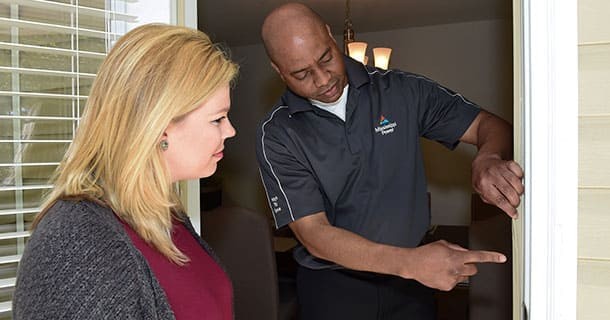Solar Energy FAQ
How do solar panels generate electricity?
Solar panels absorb energy from the sun by way of a semiconductor (typically silicon) and generate a direct current (DC) electrical source. An inverter is used to convert the source to an alternating current (AC) electrical source like that typically used in homes and businesses. Learn more about how solar works here.
Can I install solar photovoltaic (PV) panels at my home or business?
Probably, as long as the location selected is clear of obstructions that will block sunlight and there is sufficient south-facing or west-facing roof or land areas. Some shading may be unavoidable, but you want the system to have direct sunlight most of the time. Your qualified solar installer should be able to measure or calculate the degree of shading that would affect the system's operation. If the system is roof-mounted, factors such as the age, type and condition of your roof are important to consider.
Can I install my PV system myself?
It is highly recommended you use a qualified solar installer for PV installations. Compliance with local building and electrical codes are required.
Where can I find a qualified solar installer to install my solar panels?
- Mississippi Power recommends using a qualified solar installer certified by the North American Board of Certified Energy Practitioners.
- Mississippi Power recommends that you obtain multiple proposals prior to committing to a project.
- Mississippi Distributed Generation Rule also provides guidance on finding qualified installers
- Learn more about NABCEP and find certified professionals in your area here.
What kind of questions should I ask when choosing an installer?
Price is only one factor to consider when selecting a qualified solar installer. Here are some other things to consider:
- Is the company experienced or certified?
- Will the company provide references?
- How many systems has the company installed in the last year?
- How long will the installation process take?
- How long will the company monitor the installations after they are completed?
- What is the warranty period? What does it cover?
- What repair and maintenance services are offered? What are the rates?
- Does the installer guarantee energy production or energy cost savings?
- Does the installer offer financing? What is the interest rate? What are the total financing charges?
- Will the installer provide any assistance or support in filing for any available tax credits?
- What is the estimated simple payback, in years, of the proposed solar system?
Can cloudy days impact solar panel effectiveness?
Yes, clouds can disperse or block sunlight. This in turn will restrict the amount of sunlight absorbed by the solar panels and can reduce the energy output by as much as 90 percent or more.
Are some panels more efficient than others?
Yes. Efficiencies differ based on panel material and quality. Typical efficiencies range from 12 percent to 21 percent.
What is the typical power output of a residential panel?
The output of a panel is a function of the panel efficiency but typical output values range anywhere from 125 watts to more than 300 watts.
Can a PV system with or without batteries power my entire home or business? Is this economical?
A typical PV system that is economically feasible will not have the capability of providing enough power to supply an entire home or business without support from the utility grid. Many electrical appliances, particularly air conditioners, require large electrical currents to start and run. This becomes more feasible if batteries are included in the PV design, but this may cause the system to no longer be affordable or economical.
Are there any size limitations on my PV system?
In order to become a net metering participant in Mississippi, the size of a residential PV system must be 20 kW or less. For a commercial or industrial PV system, the system must be 2 MW or less.
What size PV system do I need to power my home or business?
PV system size is directly related to how much generation you need and the available area you have. By observing your monthly and annual usage, you can calculate your ideal PV system size. This is a topic you should discuss with a qualified solar installer.
What is the average/typical size of an individual panel?
Residential panels can vary in dimension but are typically around 5½ feet x 3 feet.
What is the typical space size of a rooftop PV system?
A typical 4kW residential system (1 kW = 1,000 watts) might be composed of 16 250-watt panels. This could be arranged using two rows of eight panels with a width of approximately 24 feet and a height of approximately 11 feet.
How much does a typical installed PV system cost?
Currently, the initial installation cost of a small roof-mounted solar PV system typically averages between $3 to $4 per watt. Therefore, a 4,000-watt system may cost around $12,000 to $16,000. Variables specific to the installation site, available incentives and tax credits can change the price significantly.
How long does a typical solar panel last?
Most solar panels are under warranty to produce 80 percent efficiency for 20-25 years, though some panels have been known to perform more than 40 years. Other components of the solar energy system have other lifespans. For example, micro inverters typically carry a manufacturer's warranty of 25 years, while string inverters typically carry a 5-year to 10-year warranty.
Is maintenance required for PV systems?
Yes, minimal maintenance is required. Panels should be cleaned of debris and anything else that can block the sun to ensure maximum output. Some components may need regular inspection by a professional. It should be noted that most small PV systems are located on roofs. Special care should be taken if working on the roof and while using ladders. Be aware of any electrical lines that may be in the area.
What may impact the efficiency of a PV system?
There are many variables that are involved in establishing the efficiency of a PV system. These variables include but are not limited to: amount of available sunlight (irradiance), ambient temperature, clouds, wind speed, optics (glass clarity), contamination (debris) on panel, electrical losses, and of course the quality of the system itself.
Will my PV system be covered under my property owner's insurance?
This is a question for your insurance company. It is strongly advised you consult with your insurance provider prior to installing a PV system.
What is islanding?
Islanding, also known as feedback, is a term used to describe a situation when electricity from your utility has been lost but the solar PV system continues to export power to the grid, causing a dangerous condition for utility employees and others. Inverters must adhere to the UL1741 standard which prevents this situation.
What is UL1741?
This standard requires inverters to be designed in such a way that they shut down after sensing that the utility power supply has been lost. This is a safety design that prevents the hazardous condition of islanding. The PV system must wait five minutes before reconnecting to the grid after utility power supply is restored.
How much is the federal tax credit for solar installations?
An uncapped 30 percent federal income tax credit is available for solar equipment purchased and installed by Dec. 31, 2019. If purchased and installed during 2020, the credit is reduced to 26 percent and further reduced to 22 percent if purchased and installed in 2021. There is no credit for systems purchased and installed after 2021. Please consult your tax advisor to determine how this federal incentive may apply to your particular circumstances.
Find information about tax incentives at the Database of State Incentives for Renewable Energy.



